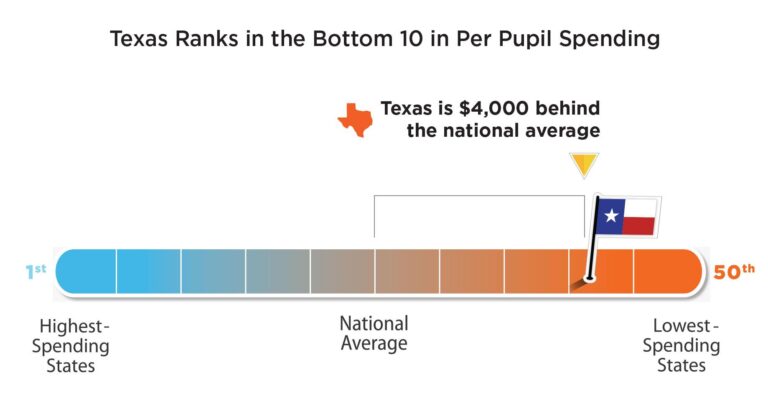Federal Investment Fuels Texas Public Education Growth
Texas public schools benefit from a significant influx of federal funding, underscoring the vital role the U.S. Department of Education plays in advancing educational quality statewide. In the current fiscal year, Texas has been awarded more than $8 billion to support a wide array of programs, including pandemic recovery initiatives, special education enhancements, and technology modernization. This substantial financial backing is designed to reduce educational inequities and provide essential tools and services to both metropolitan and rural school districts.
The federal funds are distributed through several key programs, such as Title I grants targeting economically disadvantaged schools, IDEA funding for students with disabilities, and grants aimed at strengthening STEM education. Below is an overview of the major federal funding streams allocated to Texas schools:
| Program Name | Funding Amount | Primary Objective |
|---|---|---|
| Title I Grants | $3.2 Billion | Assistance for schools serving high-poverty populations |
| IDEA Funding | $1.1 Billion | Support for special education services and resources |
| ESSER (COVID-19 Relief) | $2.5 Billion | Funds for pandemic response and recovery efforts |
| STEM & Innovation Grants | $450 Million | Enhancement of science, technology, engineering, and math programs |
| Teacher Development | $325 Million | Professional growth and training for educators |
- Equity-driven programs focus on narrowing achievement gaps.
- Technology upgrades facilitate digital learning and connectivity.
- Community engagement initiatives strengthen partnerships between schools and local organizations.
Funding Distribution Highlights Inequities Across Texas Districts
Although Texas schools collectively receive billions in federal dollars, the allocation patterns reveal significant disparities among districts and programs. Large urban districts often attract more funding for advanced technology and specialized curricula, while rural and economically challenged districts rely heavily on Title I and basic infrastructure support. These imbalances raise concerns about whether current funding formulas adequately address the diverse needs of all Texas students.
Examining specific funding categories further illustrates these disparities:
- Title I Grants: Primarily benefit districts with the highest poverty rates but may overlook moderately disadvantaged areas.
- IDEA Funding: Varies widely depending on district size and the number of identified students requiring special education.
- After-School and Enrichment Programs: More prevalent in affluent suburban districts with greater fundraising capacity.
| District Category | Average Federal Funding | Main Funding Sources |
|---|---|---|
| Large Urban | $12.5 Million | Title I & Technology Grants |
| Rural | $4.3 Million | Basic Infrastructure & Title I |
| Affluent Suburban | $9.1 Million | Enrichment Programs & IDEA |
How Federal Funding Enhances Classroom Experience and Student Services
Federal financial support serves as a cornerstone for improving educational resources and expanding student services throughout Texas. These funds enable schools to acquire modern textbooks, integrate innovative technology, and upgrade laboratory equipment, all of which contribute to a more dynamic and engaging learning environment. Additionally, federal dollars underpin critical programs such as special education, mental health counseling, and after-school tutoring, which are essential for addressing the varied needs of students and fostering equitable academic opportunities.
School districts report that federal funding empowers educators to implement customized interventions and comprehensive support systems, particularly in underfunded communities. This targeted investment not only boosts academic achievement but also promotes students’ social and emotional health. The following table summarizes typical federal funding uses and their reported benefits across Texas districts:
| Funding Area | Key Investments | Outcomes |
|---|---|---|
| Classroom Materials |
|
Increased student engagement and interactive learning |
| Student Support |
|
Enhanced academic success and well-being |
Calls for Greater Transparency and Accountability in Federal Education Funding
Recent revelations about federal education funding allocations have prompted experts to advocate for increased transparency in how these funds are distributed. Without clear and accessible reporting, it becomes difficult to verify that resources are equitably allocated and effectively address local priorities. Stakeholders urge the Department of Education to provide more granular data, enabling taxpayers and policymakers to track funding flows down to individual districts and schools.
Proposed accountability enhancements include:
- Independent audits to ensure compliance and proper fund usage.
- Uniform reporting standards nationwide to facilitate comparative analysis.
- Publicly accessible dashboards offering real-time updates on fund distribution and expenditure.
| Funding Category | Current Allocation (%) | Recommended Increase (%) | Justification |
|---|---|---|---|
| Title I Grants | 45% | 55% | To better support underserved low-income communities |
| Special Education | 25% | 30% | Addressing growing demand for specialized services |
| Teacher Training | 10% | 15% | Enhancing instructional quality and educator retention |
| Technology & Infrastructure | 20% | 20% | Ensuring equitable digital access across districts |
Summary and Future Outlook
The federal funding Texas schools receive from the U.S. Department of Education remains a pivotal factor in shaping educational opportunities statewide. As debates over budget priorities continue among policymakers and community stakeholders, transparent and detailed reporting on fund allocation is essential for ensuring resources are distributed fairly and effectively. Ongoing monitoring and analysis will be crucial to understanding the evolving impact of these investments on Texas students, educators, and communities. The Houston Chronicle remains committed to providing timely updates and in-depth coverage of these developments in Texas education finance.




